A wild sea Ickeny (Norfolk’s ritual ‘Oss) and some bleached-bone reminders of the never-ending tides of life and death. Trimingham, Norfolk, 3 November 2024
Hello and welcome to this early November/New Moon edition of Bracken & Wrack, deep in the season of Hallowtide.
As Val Thomas reminds us in her book of that name,
Samhain [Hallowe’en] rituals are often performed on the last night of October, offerings made to ancestors, candles lit and feasts shared between the living and the dead. For some, that is the work completed and, of course, the decorations and the special sweets in the Hallowe’en aisles of supermarkets have been whisked away before doors open on the first of November. For some of us, though, the days from the close of October through to Martinmas on 11 November are all sacred in their own way, drawing us into the darkness to reflect, to walk among the shadows, to face our fears and to emerge into a still-darkening world, ready to prepare for the light’s return.
Here at Bracken & Wrack, I definitely fall into the latter camp and I hope that if you don’t already feel the continuing thread of this Tide, that this newsletter will draw you a little deeper in. In fact, being mindful of the 13 days we are now adrift from the Julian calendar that was followed in England until 1752, we can extend our marking of Hallowtide with its customs and saints’ days until 13 days after Martinmas. Not only does that take us almost all the way through the month, but 24 November also happens to be St Catherine’s Eve, which as we shall no doubt see in the next Bracken & Wrack (you can tell I don’t plan ahead!) is also a day filled with folklore and mysticism and well worth the marking.
Oh, and if you would like a further taste of this Tide, you’ll find more in The Toothed Moon, posted last year around this time.
In this edition:
A Hallowtide walk along the lane
Dark & Dangerous: propitiating the blackthorn spirits
Gleams & Glimpses: rainbow lore
‘You Will Soon Make A Good Picture’: my grandad’s drawing books
Driven by an Angel: Black Shuck’s softer side
Before we get going I would just like to say a huge thank you as, on the eve of its second birthday, Bracken & Wrack now has 1000 subscribers! I’m thrilled that my newsletter is reaching so many kindred spirits and I am truly grateful to everyone who reads it. It’s probably a good moment just to quietly mention that although this little publication will always be free, I am incredibly appreciative of my paid subscribers who really do help me to keep Bracken & Wrack - and our growing community - going. If you derive value from my writing please do consider this option. As a thank you for your support there’s an ever-expanding archive of ‘between the moons’ offerings to explore, too.
Dancing Bear Wood, 25 October 2024
A HALLOWTIDE WALK ALONG THE LANE
Turning out onto the lane I feel for the scent. It’s elusive, not heavy, whisked by the wind. Although the breeze has a slight edge it’s strangely mild for early November and I haven’t even thought to pull on a jacket before setting out.
The verge-side grasses and seed heads seem more gaunt, bent at angles, and I hardly need to look up to notice that the newly-made spaces between the leaves are letting in a pale grey sky with just a hint of brightness beyond. Swept along the edge of the tarmac, dry leaves, stems and bracken fronds have already been worked by weather and footfall and are beginning to turn into gold-bronze felt.
I can see so much further into the woodland these days. The bracken melts further into the earth each day and its only the gorse that stands prickly sentinel to the wildlife within. Not that there’s much movement of any kind on this soft afternoon. The wind has dropped and there’s only a hint of the autumnal scent I crave. What my nostrils do pick up is the smell of mown grass as all the neighbour’s lawns are being given their last cut of the season while the weather holds.
Around the corner and the birches on either side gleam among the golds of the bracken’s swan song and their own fallen bounty. Honeysuckle vines hang in swathes from the lower boughs. Surely hidden magic is being wrought just beyond them, if only you could part the veil and be fast enough to catch the woodland spirits at their work?
Fringing the lane like an unrolled coil of barbed wire, the blackthorn bushes are fast shedding any pretence at summer gentility and snarl at passers-by with their sharp, sharp spines.
DARK & DANGEROUS: PROPITIATING THE BLACKTHORN SPIRITS
Soon it’s time to head back to the cottage, where, in Nigel Pearson’s Walking the Tides, I discover something interesting about the blackthorn.
Nigel tells us that as well as being Martinmas, 11 November is the date for remembering the spirits of the blackthorn tree, offering them the respect they deserve. Sometimes known as the Lunantishees these spirits are powerful indeed, as is attested by the effects both of syrupy wine-dark sloe gin and a scratch from one of their fearsome spines that will surprisingly often turn septic.
As he says, it’s fitting that these spirits are honoured at this tide of the year, as theirs is a dark reputation. As well as being notorious for its spines, the wood of the blackthorn has for centuries been fashioned into clubs and stout staves, used both for defence and attack. Its dark and dangerous reputation is compounded by its traditional use as a ‘blasting rod’ of malefic witches, with the specific aims of cursing, ill-wishing, and sending unwelcome energies back the way they have come.
I mentioned sloe gin, and of course many people are familiar with the making of this warming midwinter aperitif which also acts medicinally as a digestive and laxative. Magically (or so it seems), by means of sugar and spirit the astringent, sour fruit of the blackthorn is transformed into an eagerly-anticipated nectar best sipped by a fireside whether indoors or out.
And it seems to be good advice when Nigel concludes: A libation of sloe gin, or failing that of *milk and honey to sweeten their temperament, is very welcome to the blackthorn spirits at this time and goes a long way towards getting them on your side in any emergency, as they are woefully neglected by most people.
*As a vegan I would substitute oat milk and maple syrup which I feel in my bones sends the same message of regard and nurturing to the Lunantishees and is likely to be just as warmly accepted.
Blackthorn baring its spines along the lane, 4 November 2024
GLEAMS & GLIMPSES: rainbow lore
With the storms and changeable weather that often pepper the month of November, I’ve often found myself under skies that are one moment black and the next sparkling with watery sunshine. So I thought this could be a good moment to turn to our Victorian Yorkshire wise woman for some weather guidance concerning rainbows.
I haven’t actually been lucky enough to see a rainbow myself for a while, but a few days ago I was reminded of their beauty and mystery during a chance conversation beside the nearby canal at Ebridge Mill. There, we fell in with an old man who I swear was the elfin guardian of the place. He told us of a rainbow full and bright whose hooped arc exactly spanned the flowing waters. Of course, its image was reflected end to end on the rippling surface. Can you imagine how it must have felt to stand there before the complete circle, feeling perhaps that if you could only step through its portal you would find yourself in fairyland?
Here is what the wise woman has to say - but please do share further rainbow lore if you know of any :-)
If you see a rainbow in the morning, pelting rain will not be long in coming, but the sun will be behind it to make the sky like a pewter dish, and the rain will fall and fall prettily like showers of silver elf-bolts.
If you see a rainbow in the evening, it is as fair a token of the sun on the morrow as is a sky of crimson; the shepherd’s delight.
When you see glimpses of a rainbow all broken up by a cloudy sky, and those clouds sailing fast like ships at full mast, the wind that drives them will rise and increase, storms will come and even afterwards the wind will remain all of a bluster-and-a-fluster; that is why these gleams and glimpses of parts of the rainbow are called wind-dogs; and if you whistle to them, you’ll change the direction of the wind.
Changeable skies and a high tide, Walcott, Norfolk, 30 October 2023.
Yet but awhile the slumbering weather flings
Its murky prison round - then winds wake loud;
With sudden stir the startled forest sings
Winter's returning song - cloud races cloud,
And the horizon throws away its shroud,
Sweeping a stretching circle from the eye;
Storms upon storms in quick succession crowd,
And o'er the sameness of the purple sky
Heaven paints, with hurried hand, wild hues of every dye.
John Clare, ‘November’ (extract), The Shepherd’s Calendar
‘YOU WILL SOON MAKE A GOOD PICTURE’: Holley’s drawing books
The earliest of Holley Ashmore’s five drawing books, dated 1905-1906
At this time of mist, woodsmoke and curling bracken, separation between the living and the dead feels wafer-thin. Little wonder if we make new discoveries about the lives of our ancestors and departed loved ones, whether through deliberate seeking in our own world or through spirit contact, intuition or divination.
I was looking for some old family photos to prop up for Hallowtide and knew that in the bedroom cupboard lay a muddled bundle in a big plastic storage box where they had been hastily placed after their rescue during the final stages of clearing my mum’s house. Several of the faces are difficult to identify as the images are unlabelled, and many of the photos are surprisingly tiny. So much so that you would be hard pressed to fit one name on the back, let alone two or three. Anyway, I found what I needed.
The bundle in the box was actually a mixed lot. Photos, yes, but also a big folder of my childhood writings. Some were primary school projects written in proper ink pen, some were the starts of illustrated books that seem to have petered out or at least are now missing their endings, and other things - mainly poems - laboriously typed letter by letter on my dad’s manual typewriter (see This Flushed October).
These I had already discovered, but what I had forgotten, or at least scooped up without studying, were the five drawing books belonging to my grandad, Holley Ashmore. Opening each one I realised that they covered the years 1905 to 1908 when he was between nine and twelve years old, and consisted almost entirely (with a few exceptions) of botanical sketches.
Drawing book - age 9
Drawing book - age 10. None of the species are labelled but the hazel on the left hand page is easily identifiable
Drawing book - age 12 and nearly time to leave school
Family tradition has always stated that, like many others at that time, Holley left the village school at the age of twelve with whatever learning he had picked up and then had to work at his father’s trade. In his case that was the work of the village wheelwright, coach builder and painter, who also owned plum orchards and a smallholding and ran a milk round. The date that the last book finishes suggests that he probably left school as soon as he reached his thirteenth birthday, which you were allowed to do provided you had made sufficient attendances.
Little did he know that at seventeen he would be joining up for the First World War, from which many of his school friends would never return.
What a gift it is that every sketch is dated. I flicked through all the books, noticing how Holley’s observational and drawing skills became more honed year by year. Although these were school books I had the strong sense that his interest in drawing extended far beyond what his lessons required of him. And this was confirmed when I found, proudly tucked into the front of one of the books, a folded note in the spidery writing of the era.
The letter is a little enigmatic as one or two of the words are hard to make out. I have no idea who Mr White was, nor his relationship to Holley. And it’s a shame the address is no more than a squiggle. I’m sure, though, that Mr White wasn’t the class teacher. Perhaps Holley sent the card to him for critique, and if so that was quite a bold thing for a 10-year-old to do, especially as he came from a background where hard practical work probably left little time for leisure pursuits. In any case he was proud enough of his own drawing to send it to someone else, and the recipient was clearly impressed by what he saw.
January 17th 1907
Dear Holley,
I was pleased to receive your card and to find it your own work. I hope you will continue to practice and have no doubt if you do so you will soon make a good picture. I would like to see a sketch taken somewhere round about your [?]parish. Do it from the place itself not from a picture. I am sending you today a box of colours which I daresay will prove of use. I hope you and your parents are well.
With best wishes.
Yours artistically
[?] White
I feel very lucky that the five books have come to me and that I pulled them out at this time. Luckier still that the note was still safely tucked inside one of them. It’s this sort of find that really draws the ancestors close and gives us tiny insights into what excited them and brought them joy when they are no longer here to ask in person. Do you have any accidental treasures like this?
Making soul cakes for the ancestors
DRIVEN BY AN ANGEL: Black Shuck’s softer side
In the last edition of Bracken & Wrack I wrote a little about Black Shuck, usually imaged as a giant ghostly hound. This terrifying sometimes headless - apparition with eyes like saucers is said to haunt the lanes and byways of East Anglia. Although, as I said then, Suffolk has fair claim on him with strong traditions pertaining to both Bungay and Blythburgh, Norfolk also has its share of tales and sightings. Here, he is said to rise from Beeston Bump and to be especially active around Overstrand.
Shuck’s name and legend are seen on many Norfolk products. And circling back to sloe gin, one of the best known businesses bearing his image happens to be the Black Shuck distillery where Black Shuck Sloe Gin is made. In their literature, as everywhere it seems, Shuck is depicted in his usual frightening and ill-omened guise.
But there seems to be another side to this legendary hound. Indeed, he may not even be a hound at all, as we shall see in Part 3. But staying with our giant black dog for now, I had a bit of a lightbulb moment when researching for At The Thicket’s Heart. In his online article on the subject, James Thurgill speaks of the variety of names that different regions of the UK give to their own versions of Shuck:
‘Sightings of ghostly black dogs are common throughout Britain and are a staple of its folklore; Yorkshire is menaced by the Barghest or Padfoot, Hertfordshire by the Leandog, Lancashire has The Grim, Lincolnshire is haunted by ‘Hairy Jack’ and Devon the Yeth Hound. Other black dogs are said to roam the counties of Bedfordshire, Surrey and Wiltshire. Wales and Scotland also have their own wealth of spectral hounds. But of all the tales of all the dogs, it is Shuck who is the most infamous and indeed the most terrifying.’
It was this mention of the Barghest of Yorkshire that immediately rang a bell. Knowing so well - as I do - the words of the Yorkshire wise woman in my old friend Earth Magic I was sure I had seen mention of this name somewhere around Hallowtide. Yes, there it was, in a piece entitled ‘Charm to Call upon the Bargest’.
Shall we let the wise woman take up the tale?
‘There is a guardian hound, a good dog, upon which you may call, should it fall upon you to have to journey home in the dark, or across a lonely stretch of the countryside; yet if you are afraid do not be chary of summoning the Bargest wherever you are, whether it be town or wilderness, as he will always come to those of good faith.’
After giving three rules of etiquette when dealing with the hound, she goes on to give the call that should be spoken three times over:
Good dog, gentle hound
To my journey’s end I’m bound;
I bid thee in Christ’s name so pure
Walk thou with me to my door.
Guard me from harms and all foul weather
Bargest! Bargest! Come thou hither!
The wise woman assures us that ‘Soon you will see, or perhaps just hear, a great black dog padding softly behind you, bigger than a horse; or it could be that you will perceive only a shadow, or the ghost of its breath. Do not let your heart be troubled, for the Bargest is driven by an angel and no better protection could you have in this world.’
Well, what an interesting contrast to all the diabolical Shuck stories. And as if this wasn’t enough, my piece about the hideous spectral hound attracted a fascinating comment from Amanda Dixie of Beneath the Wise Oak Tree here on Substack. Amanda told me that where she lives in Somerset they have the Gurt Dog, who ‘looks very similar to Shuck but is actually a kind hound who protects children and guides them home if they get lost.’
Plenty to think about there, don’t you think?
Until next time.
With love, Imogen x
Witch’s brooms, Dancing Bear Wood, 25 October 2024



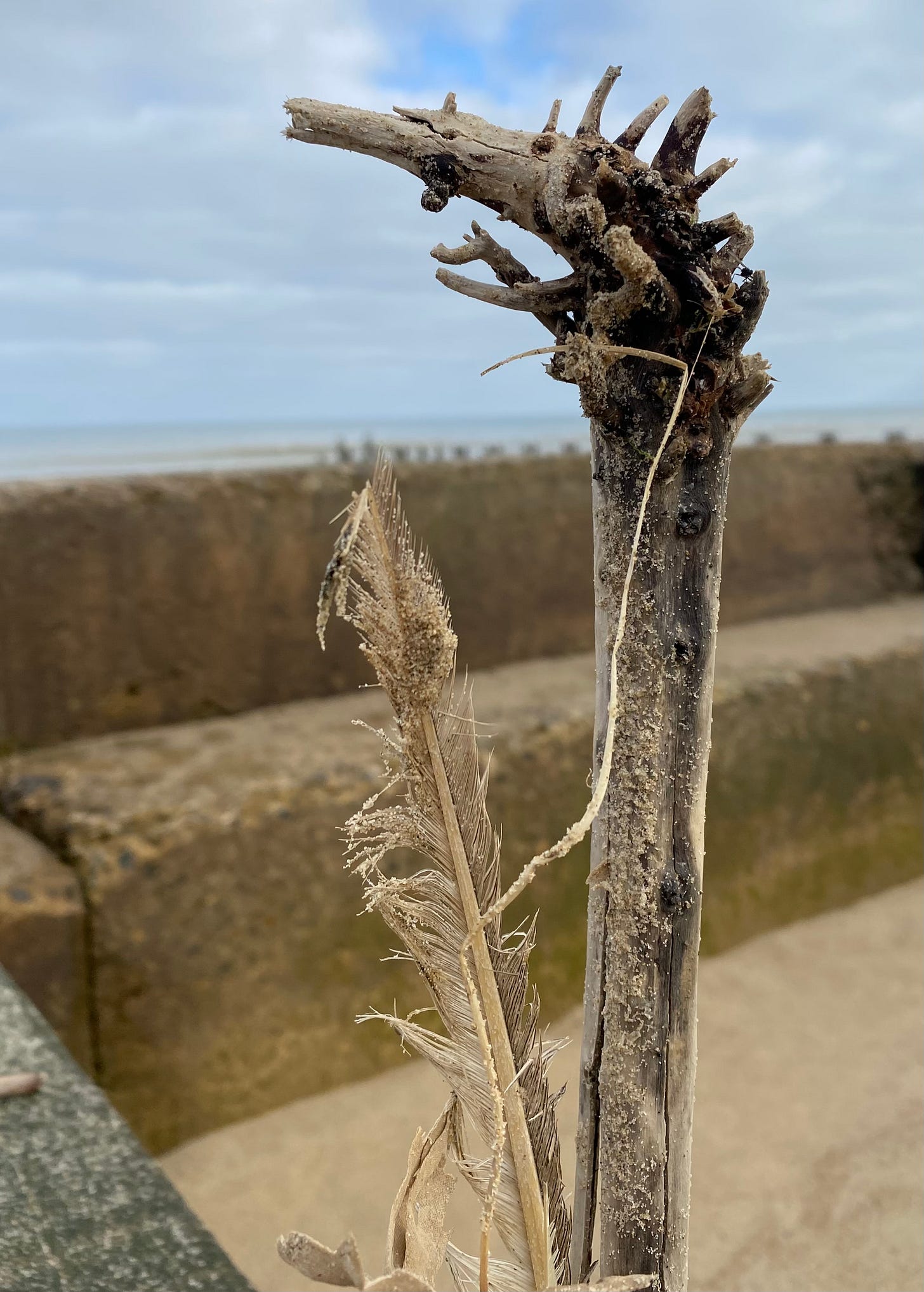


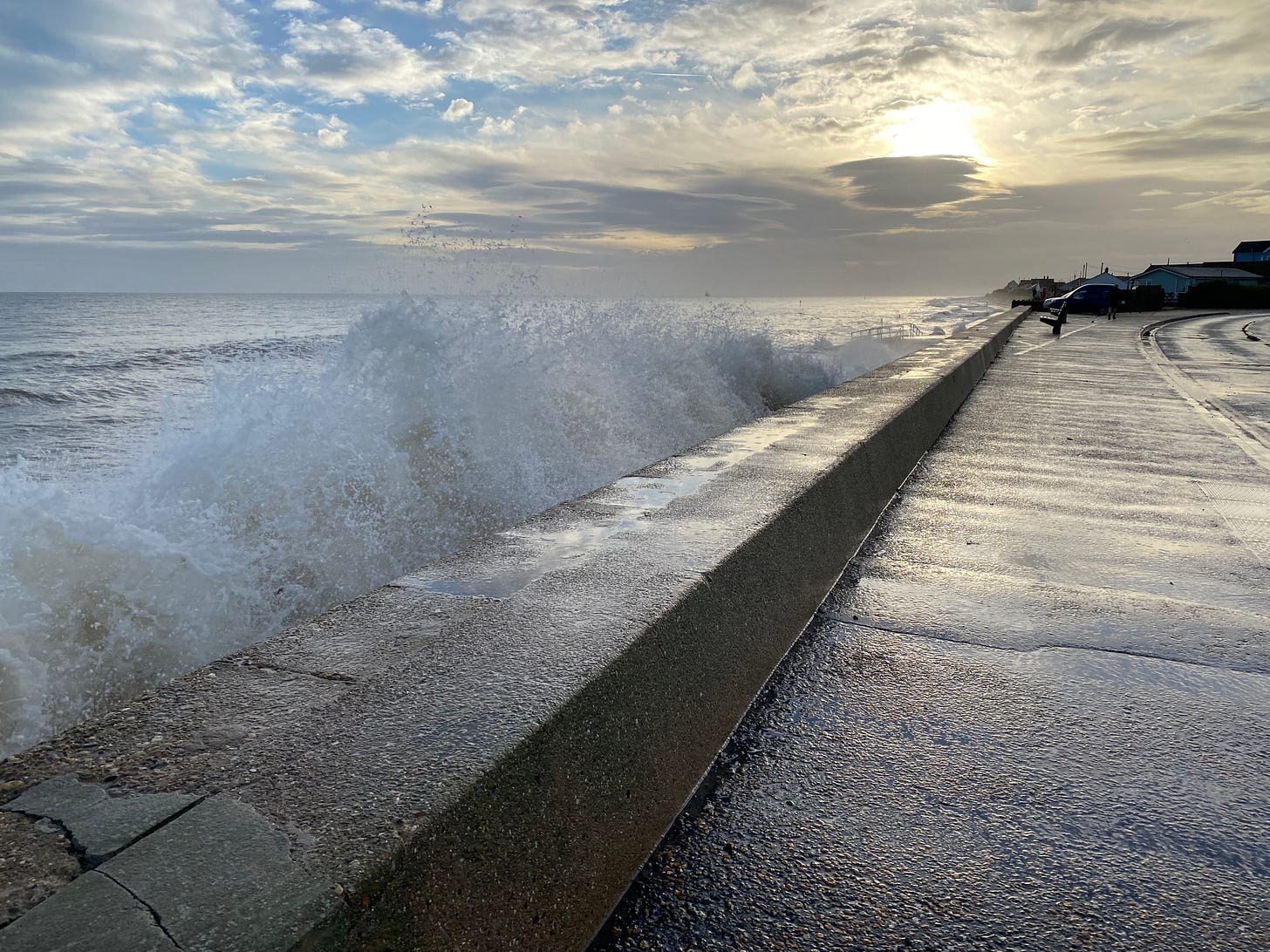
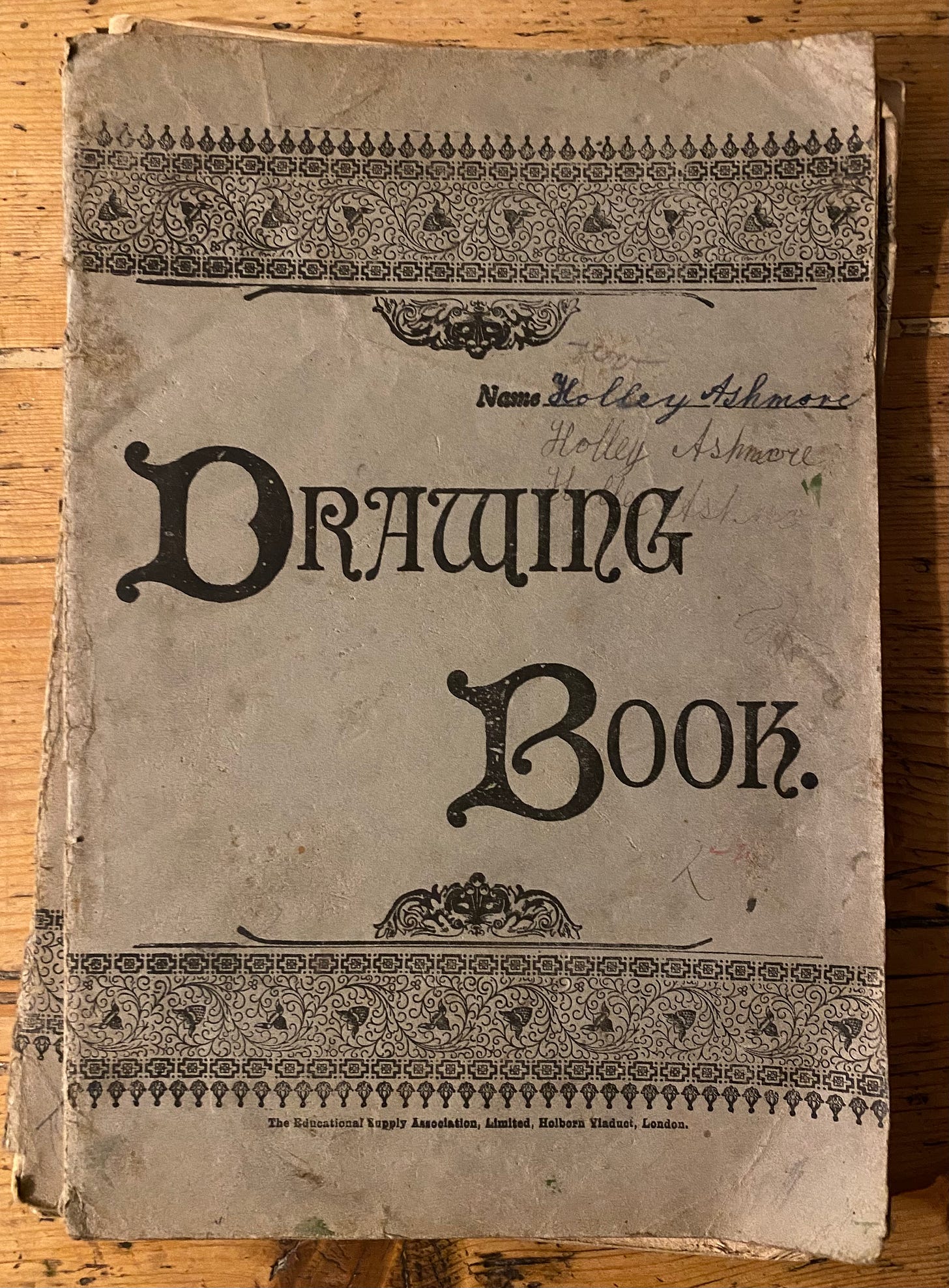
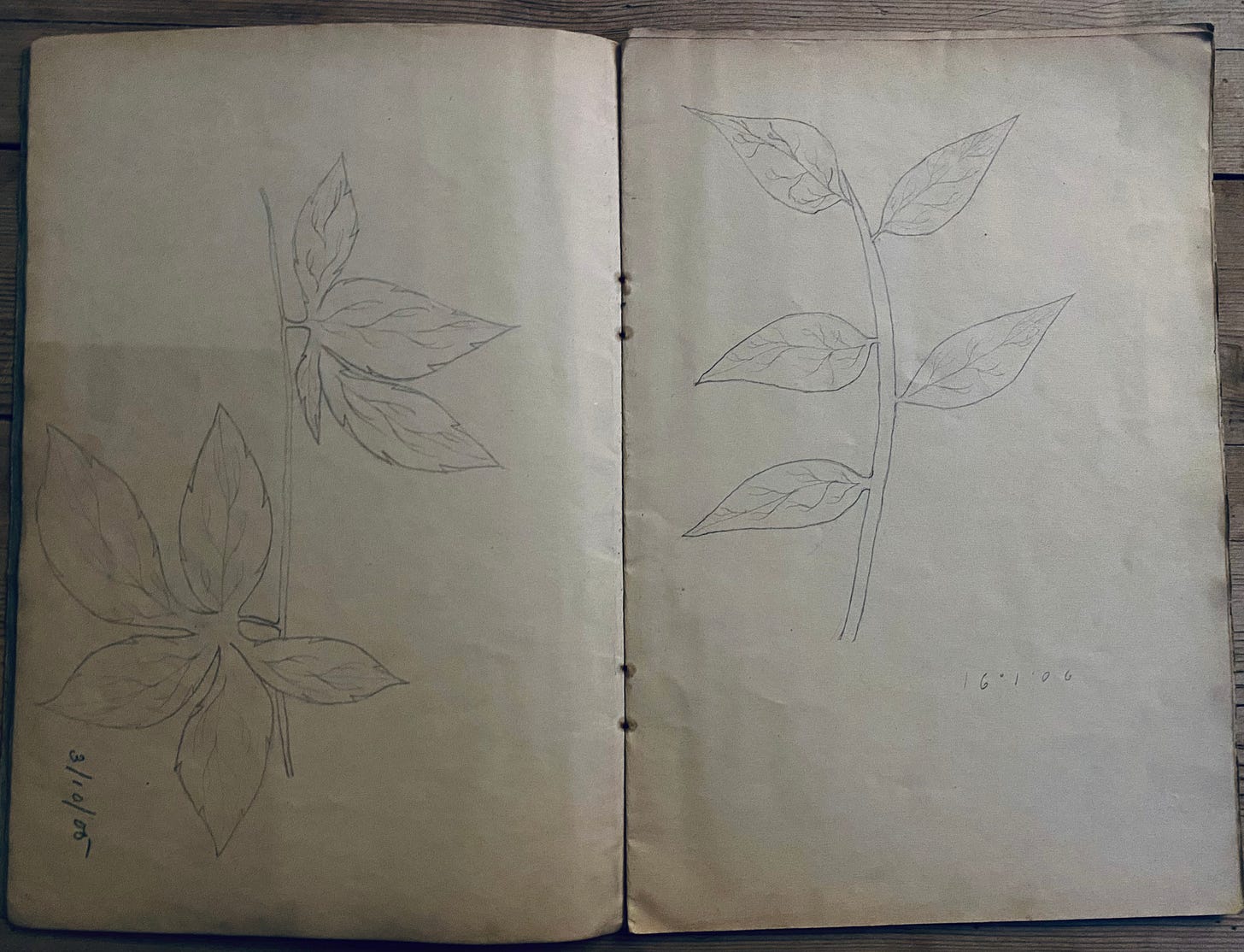

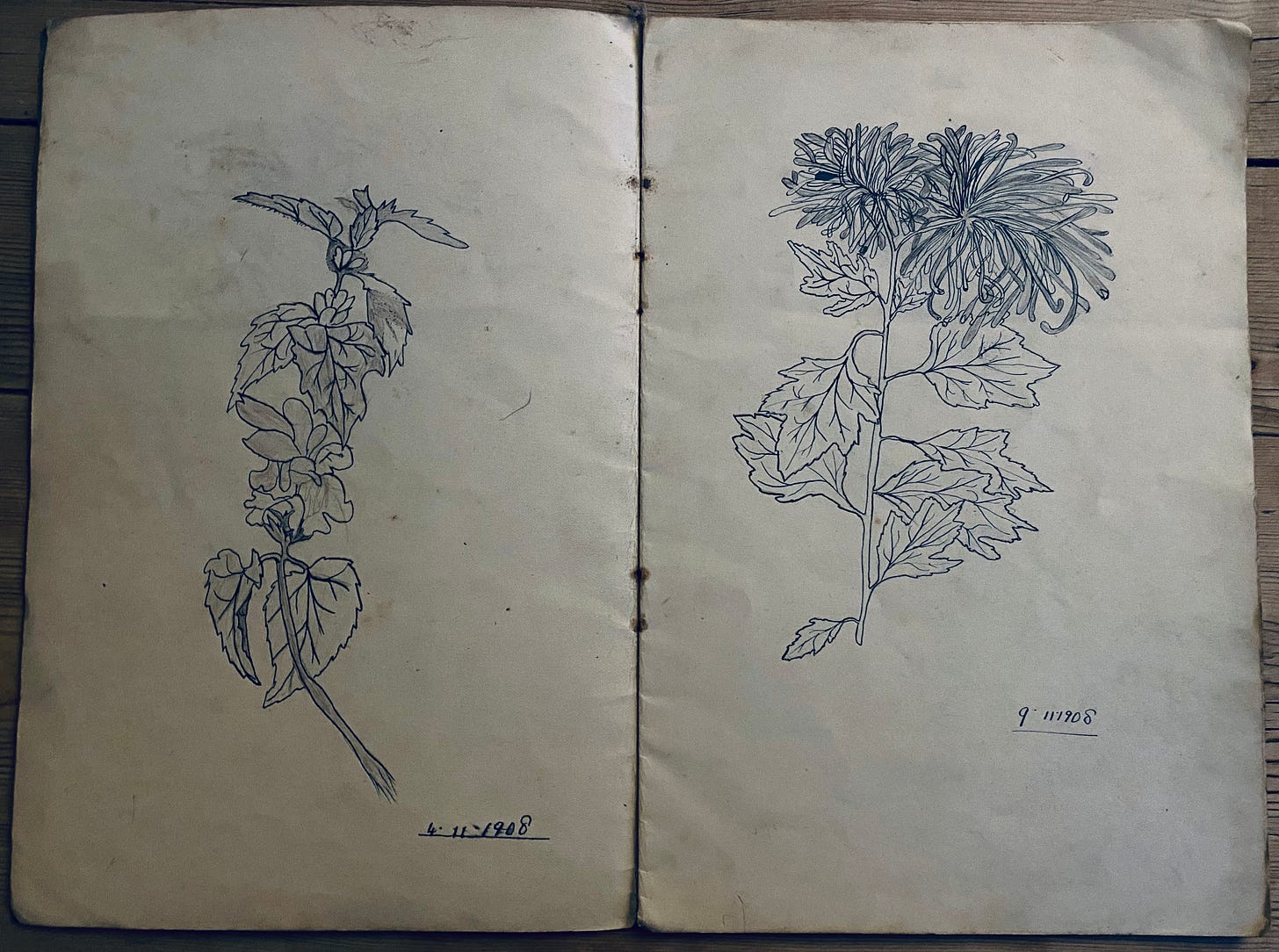
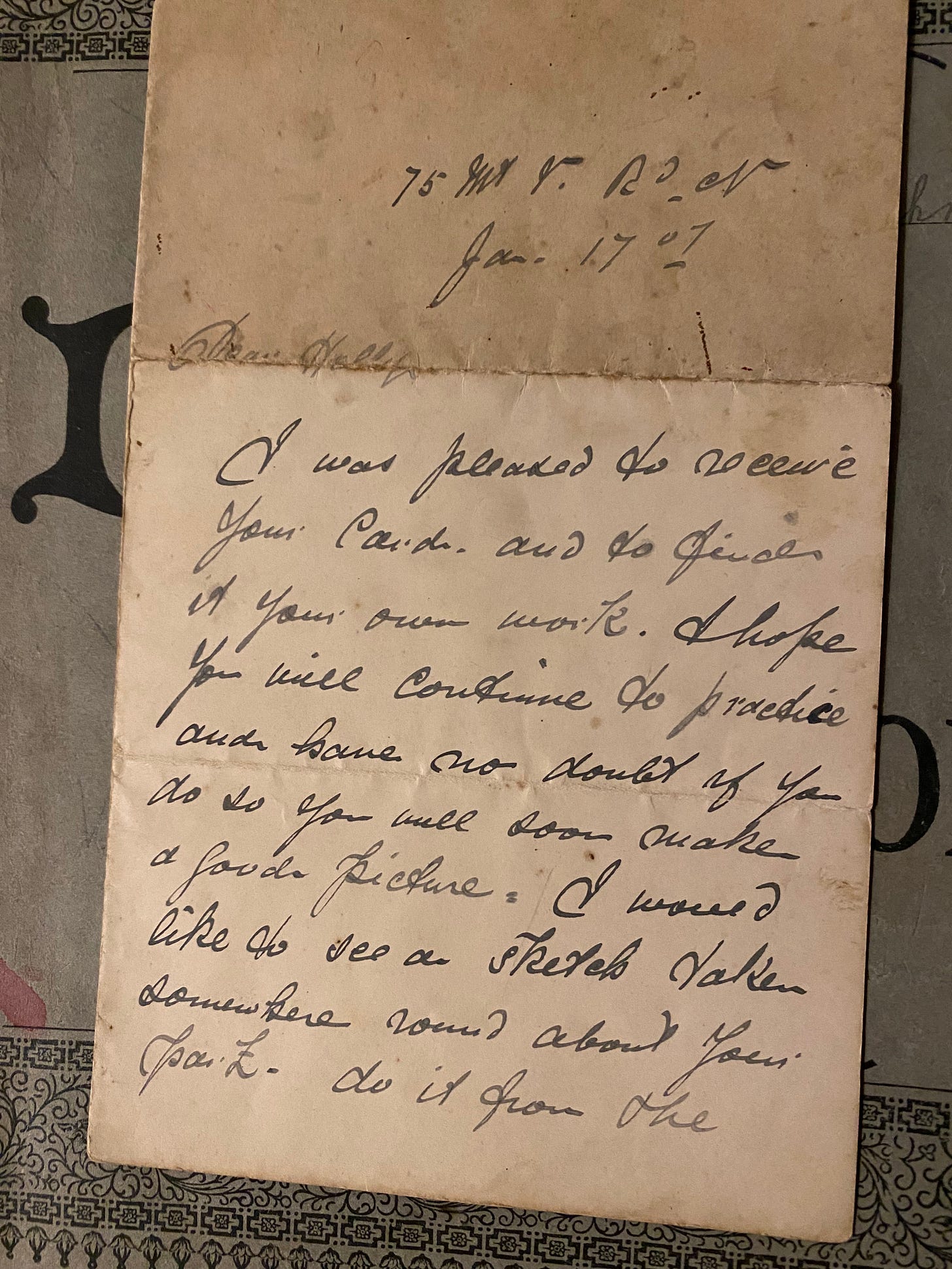
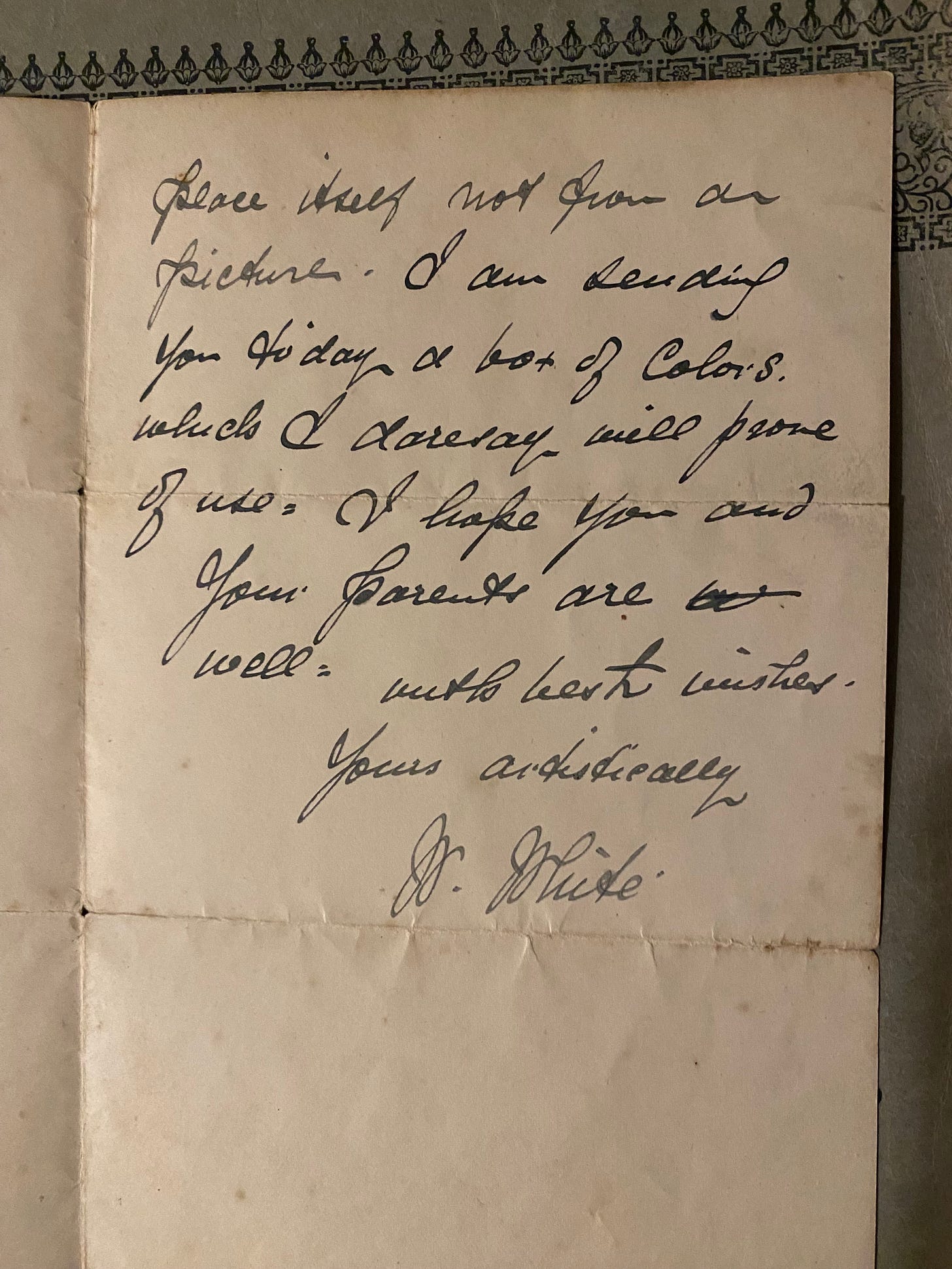
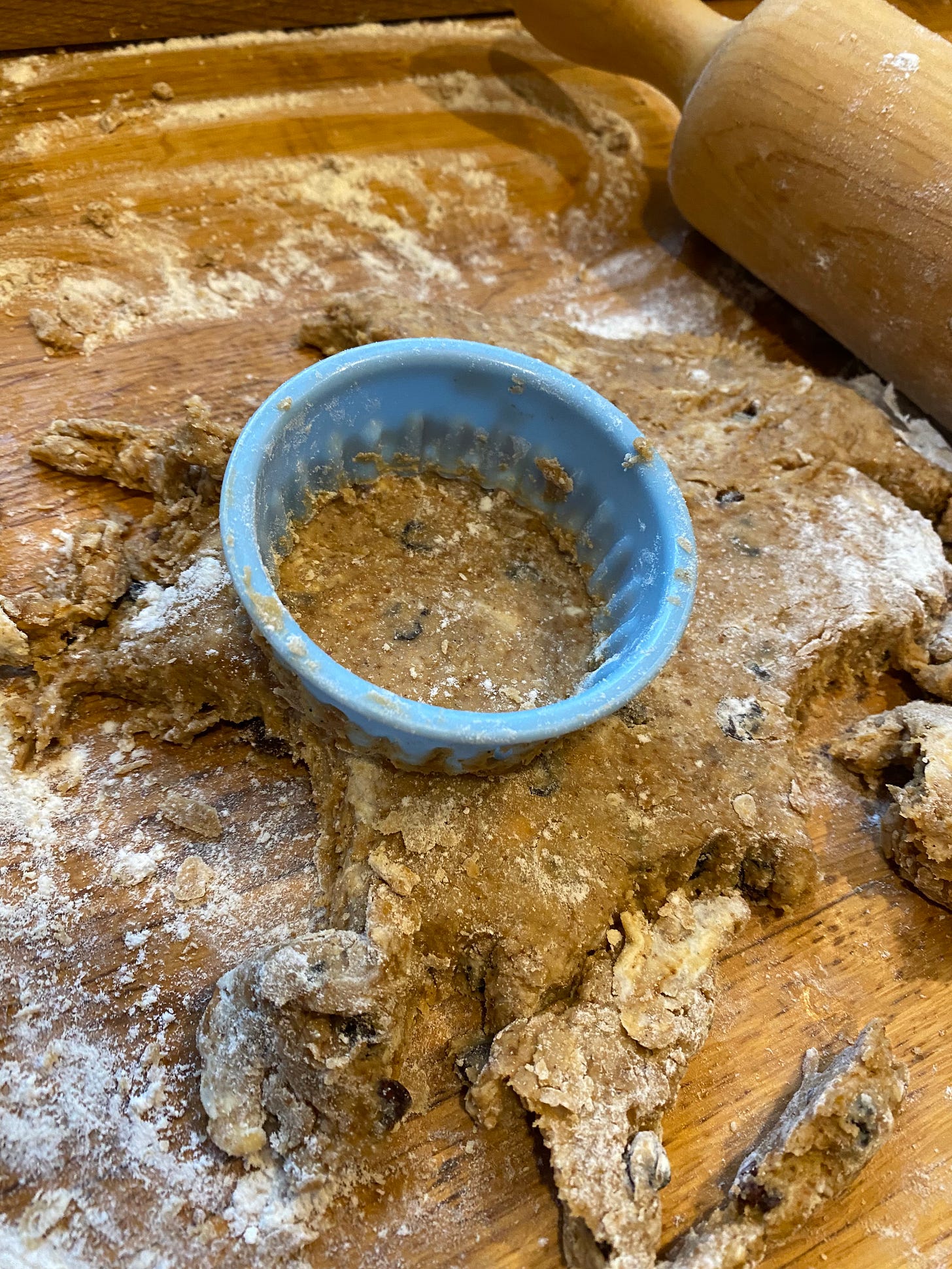


11:11 is also a portal. This is one of my favourite times of year. It seems that many of us are enjoying a warm November That photo of the high tide is amazing. I love that you have your grandfather’s drawings. I always enjoy your writing.
There is a lot of info about 11:11 portal on You Tube and around the webs. Here is one of them :
https://archive.constantcontact.com/fs013/1101726700582/archive/1108166275132.html